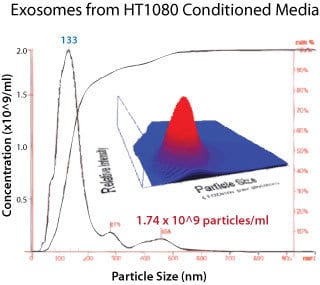ExoQuick TC for Tissue Culture Media
- Bilder (2)
| Artikelname: | ExoQuick TC for Tissue Culture Media |
| Artikelnummer: | SBI-EXOTC50A-1 |
| Hersteller Artikelnummer: | EXOTC50A-1 |
| Alternativnummer: | SBI-EXOTC50A-1 |
| Hersteller: | System Biosciences |
| Kategorie: | Molekularbiologie |
| ExoQuick TC 50ml |
ExoQuick-TCFast, scalable exosome isolation from tissue culture media A better way to isolate exosomes "We therefore pursued the ExoQuick® method for further study, as these samples required much less sample input, a key benefit when working with clinical samples and mouse models(1)." Need exosomes? SBI's ExoQuick-TC enables high-throughput, quantitative isolation of exosomes from low volumes (as little as 1 ml) of tissue culture media and certain biofluids (saliva, urine, follicular fluid, and breast milk). Note, to isolate exosomes from serum, plasma, or ascites fluid, use the original ExoQuick formulation (EXOQ5A-1 or EXOQ20A-1)). Compatible with a wide variety of downstream applications, ExoQuick-TC is an effective and proven alternative to ultracentrifugation(1-3).
ExoQuick-TC is a proprietary polymer that gently precipitates exosomes. First, pre-clear your samples of cells and cellular debris, and then simply add the appropriate amount of ExoQuick-TC to your cleared biofluid, refrigerate, and centrifuge (see the product manual for protocol details). Your exosomes will be in the pellet, ready for resuspension in an appropriate solution. In electron microscopy studies, exosomes isolated with ExoQuick-TC appear similar to exosomes isolated using ultracentrifugation(1-2), and these exosomes are also active in numerous functional assays(1-3). Exosomes isolated with ExoQuick-TC can be used for all types of protein profiling and protein characterization studies, such as mass spectrometry, Western blotting, ELISA, and more. Higher protein yields are achieved by ExoQuick purification than by chromatography, DynaBeads, or ultracentrifugation. Exosomes isolated with ExoQuick-TC also provide excellent samples for studying exosome-associated nucleic acids such as microRNAs, siRNAs, and even mRNA. Quantitative analytical techniques such as qPCR, microarray studies, and next-generation sequencing are all compatible with nucleic acids isolated from ExoQuick-TC-purified exosomes. Backed by a growing number of publications, ExoQuick-TC is often the best option for researchers working with low sample volumes, such as clinical research samples or small animal models. ExoQuick-TC exosome isolation methods are patented technologies(4). REFERENCES
How It WorksHigh-throughput, quantitative exosome recovery ExoQuick-TC can be used to purify exosomes from a wide variety of tissue culture media4, and from certain biofluids such as saliva1, urine2, follicular fluid3, and breast milk5. With a simple workflow involving minimal hands-on time and low input sample volume requirements, ExoQuick-TC is an excellent option for researchers who need to purify multiple exosome samples.
Isolated exosomes can be found in the pellet and resuspended in an appropriate solution. You can verify the presence of exosomes with a number of different methods, including Western blotting for general exosome markers (CD63, CD9, CD81, and HSP70), NanoSight analysis, or EM (learn about different ways to detect exosomes and more in our Exosome Basics Guide). The Bottom Line
Supporting DataCharacterizing ExoQuick-TC exosomes with NanoSight Exosomes purified with ExoQuick-TC from tissue culture media show the expected particle size distribution and high concentration yields when analyzed using NanoSight’s Nanoparticle Tracking Analysis (NTA, Figure 1).
Figure1. Exosome size distribution and yields from tissue culture media. Cells from a human HT1080 lung sarcoma cell line were cultured in conditioned media (serum-free) for 72 hours. 10 mL of media was combined with 2 mL ExoQuick-TC, incubated overnight at 4°C, and centrifuged at 1500g for 30 minutes to isolate exosomes. The exosome pellet was resuspended in 1 mL PBS, diluted 1:40, and visualized on the NanoSight LM10 instrument. The analysis shows that ExoQuick-TC recovered 133 nm exosomes at a concentration of 1.74 x 109 particles/mL. |
| Lagerung: | See Manual |


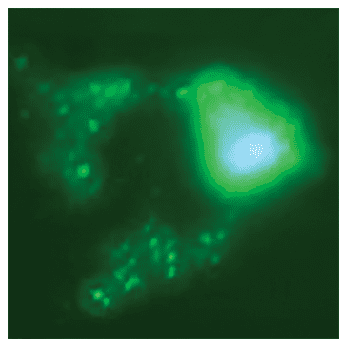
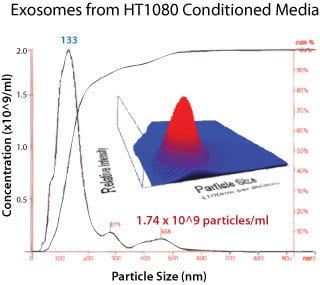
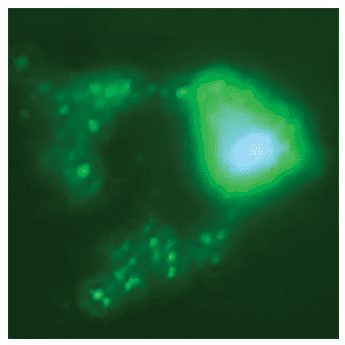 ExoQuick-TC’s fast, ultracentrifugation-free method:
ExoQuick-TC’s fast, ultracentrifugation-free method: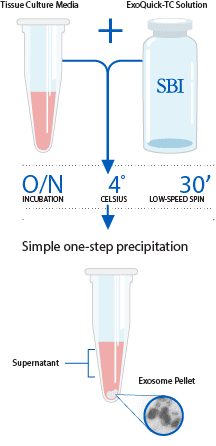 To isolate exosomes from tissue culture media, simply:
To isolate exosomes from tissue culture media, simply: